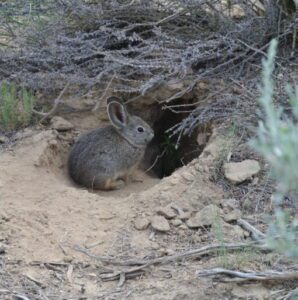Author: Scott Bowler | Published: November 14, 2023 | Category: Species Spotlight
This article originally appeared in the Fall + Winter 2023 Desert Ramblings
Conservation efforts offer hope for this undeniably cute desert species.
“Oooh! Cute Bunny!” It seems like every little critter gets the “cute” label nowadays, but the pygmy rabbit actually is a darn cute little critter. Emphasis on little, as they’re the second smallest of the Lagomorph clan after the pika, a group that also includes rabbits and hares.
Pygmy rabbits (Brachylagus idahoensis), meaning “short rabbit first identified and found in Idaho,” are our smallest rabbit, after the three larger native and introduced cottontail species and the brush rabbits of North America. While they are obviously a rabbit, they’re only about as big as a grapefruit and weigh about a quarter to a half pound. They’re a dull tan color, have very small ears, and sport a tiny tail, suiting them to their desert environment and underground living quarters. While they do look like a cottontail, those guys are a good bit bigger with longer white rimmed ears and larger, whiter tails—and are much more common. Chances are that you are usually seeing cottontails in the high desert unless you spot the pygmy’s key characteristics.

Pygmys are a sagebrush obligate critter, meaning they are dependent upon the plant for both food and shelter, and are thus only found in healthy sagebrush communities in the Great Basin and beyond. Unlike pika, they do not store food and must forage every day. Interestingly, pygmys sometimes even climb up into a sagebrush—well off the ground—which is why the first one I saw startled me, since it was about 3 feet high!
Pygmy rabbits also dig their burrows in sagebrush stands and are, in fact, the only rabbit in North America that digs its own burrow. You’re most likely to find them in the least disturbed areas with moderate sagebrush cover, plenty of undergrowth, and with deeper and looser soils to burrow into.
These rabbits have a shorter gestation and breeding season than most other Lagomorphs and time birth with the likely emergence of new spring growth, so exactly when they do so is keyed to their habitat: in higher and colder areas babies will arrive later in the spring than in warmer lowlands. And since they can have up to three litters of as many as six babies a year, they do indeed breed like rabbits.
Their rapid reproduction might be key to pygmy rabbit survival. The species is threatened by both predation and habitat loss. They fall prey to a variety of predators: coyote, weasels, and owls primarily; fox and hawks less so. Meanwhile, wildfire, climate change and development pressures limit their habitat. Both federal and state agencies have identified pygmy rabbit as a species of conservation concern.
ONDA’s conservation efforts throughout the high desert, and particularly in the Greater Hart-Sheldon, offer hope for this cute, and iconic, desert species.
Learn more at www.onda.org/core-pygmy-rabbit-habitat.
